Book Title: New Documents of Jaina Paintings Author(s): Moti Chandra, Umakant P Shah Publisher: Z_Mahavir_Jain_Vidyalay_Suvarna_Mahotsav_Granth_Part_1_012002.pdf and Mahavir_Jain_Vidyalay_Suvarna_ View full book textPage 9
________________ 356 : SHRI MAHAVIRA JAINA VIDYALAYA GOLDEN JUBILEE VOLUME at Palam shows a different approach to painting. The farther eye is eliminated but in composition, the colour scheme, and in the representation of the human figure the legacy of the old tradition is present. But this legacy of the older tradition was not the sole property of the Jaina manuscript illustrators alone. The Hindus as well started to patronise painting. In 1516 A.D. the Aranyaka Parvan of the Mahabharata17 was illustrated at a place near Agra. It shows the same characteristics as the Mahāpurāņa. The painting in Uttara Pradesh was not confined to religious texts alone. The work of the poets in Avadhi, such as Mulla Davood (the author of Laur Candā who lived in the third decade of the fourteenth century) and Kutbun (the author of Mirgavati who lived in the early sixteenth century) became favourite subjects of painting. The Laur Canda, as is evident from the stray leaves in the Bharat Kala Bhavan, began to be illustrated in the closing years of the 15th century, and follows the Western Indian technique. In the early 16th century, however, it seems to have received royal patronage as the illustrations on Laur Canda in the Prince of Wales Museum 18 prove that under the new developments, the style assumed a richness that is beyond one's imagination. It may be truly termed as the classical style of Uttara Pradesh in the early 16th century. What happened during the Mughal period to the popular religious Jaina and other themes in Western India is well-known. Painters in Gujarat played an important part in the Mughal atelier of Akbar. Soon the pupils of these painters spread out in search of their livelihood to Gujarat and Rajasthan and this laid the foundation of the Popular Mughal style. This is a style in which though the figure drawing and costumes and to a very limited extent the landscape are indebted to the Mughal style yet the older traditions both in colour and landscape persist. The influence of the Mughal painting in that of Western India is manifested in two styles: the Popular Mughal style in which the Mughal style is used with a certain simplicity and the Folk style which has only certain resemblances with Mughal painting but which was used very extensively for satisfying the popular demand. 17 Moti Chandra and Karl Khandalavala, An Illustrated Manuscript of the Aranyaka Parvan, Journal of the Asiatic Society, Bombay, New Series, Vol. 38, pp. 166-221 and plates. 18 Karl Khandalavala and Moti Chandra, Three New Documents of Indian Painting, Bulletin of the Prince of Wales Museum, Bombay, No. 7, pp. 23-34 and plates. Jain Education International For Private & Personal Use Only www.jainelibrary.orgPage Navigation
1 ... 7 8 9 10
